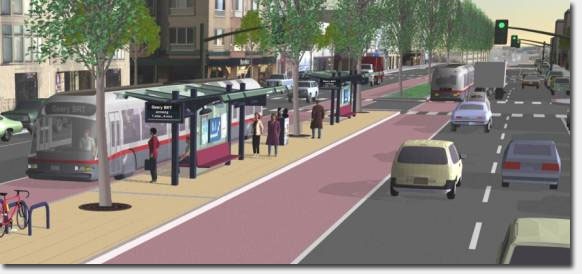
On Monday night, July 27, Supervisor Eric Mar and his staff will co-host an informational meeting about the Geary Bus Rapid Transit plan, a.k.a. Geary BRT, which aims to bring pedestrian and street improvements to Geary Boulevard in 2012/2013.
The meeting will be held at the Richmond Recreation Center (18th Avenue between Calif. and Clement) from 7-9pm.
Some more information about the BRT from the project website:
Bus rapid transit (BRT) is a quick and relatively inexpensive way to speed up buses and make service more reliable and comfortable. BRT systems typically:
– Give buses their own traffic lane so they can run faster with fewer impediments;
– Give buses priority at traffic signals so they spend less time stopped at red lights;
– Provide real time information to riders so they know when the next bus is coming;
– Build high-quality and well-lit bus stations to improve safety and comfort; and
– Provide streetscape improvements and amenities to make the street safer and more comfortable for pedestrians and bicyclists accessing the transit stations.
Geary Boulevard is the most heavily used transit corridor in the northern part of San Francisco. Over 50,000 daily transit riders rely on Geary bus service, which is often unreliable and crowded. The implementation of BRT features, such as dedicated bus lanes and high-quality bus shelters, is being considered to improve service for existing riders, attract new transit riders, and prevent increased auto congestion caused by existing riders switching to driving because of dissatisfaction with transit.
What are the benefits of BRT?
Experience in other North American cities has shown that bus rapid transit can reduce transit travel time by 15-30%, and improve transit reliability by 25-50%. This range reflects anticipated variation between side-running vs. center-running designs and among comparable systems including: Oakland, Pittsburgh, Los Angeles, Las Vegas, Boston, and Vancouver.
How might BRT affect service on Geary?
All of the BRT service plans being evaluated are anticipated to increase transit service by reinvesting the majority of the travel time savings back into Geary Corridor service. The 38L-Limited would transition into the BRT route and the hours of operation would increase to match the light rail system (approximately 5 am to 1 am), with Sunday service. Various combinations of local and BRT service will be analyzed to determine the best way to meet demand.
Would the BRT project improve walking and biking on Geary?
Yes; the Study has pursued a strong commitment to turning Geary into a “Great Street” and meeting the spirit of the City’s complete streets policy. All of the designs include a major investment in the pedestrian environment, including well designed medians, shorter crossing distances, landscaping, and pedestrian countdown signals. The Study has also sought to address the needs of bicycle riders by evaluating how cyclists can safely access the BRT system from adjacent routes on the bicycle network and providing bicycle racks at all BRT stops. The BRT project is expected to make Geary safer for both bicycling and walking by reducing conflicts with buses and reducing the number of traffic lanes on Geary.
Read more Frequently Asked Questions about the Geary BRT.
For all the nitty gritty details, attend the meeting and ask whatever questions you have, or visit the Geary BRT project website at gearybrt.org.
Sarah B.
$200 million to cut travel time by 15-30% for riders, and increase by at least as much for drivers?
Sounds like a great idea. Especially considering that the city budget surplus is out of control.
Seriously, though, I’m all for the public transit, but in this case I don’t think the improvement justifies the cost and pain for the drivers. But if the goal is to make the city unlivable for drivers, then it’s a move in the right direction. It already takes 20-25 minutes to get to any freeway, except 101 North, and it will get worse if one line on Geary goes away.
I have reservations as well, namely that making these upgrades will actually result in more ridership on Muni. Sounds a little idealistic to me. That said, a dedicated lane makes a lot of sense for Muni since I often find myself negotiating around the 38 on Geary since it doesn’t pull into the bus stops, blocks traffic etc.